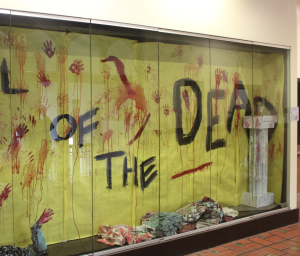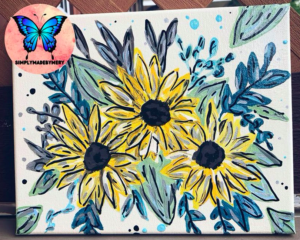Installation Art
Artwork, although always unpredictable and intriguing, may feel too restricted for those artists who visualize a piece whose story cannot be told in a painting—but instead needs to be larger, more ornate, and three dimensional. Many contemporary artists have turned to installation art—a conceptually brilliant medium that uses inanimate objects and technology to create one giant piece that captures the attention of an audience, and offers a new perspective of time and space.
Ann Hamilton is one of the most well known installation artists, having produced over sixty pieces involving video, photography, and a human presence. Her most famous work was her “Crying Wall” piece from 1997, featured in the Contemporary Art Center in New York. Hamilton set up a water tank behind a gigantic, glistening white wall, and used a scientific process to make the water drop like tears along the top of the wall, establishing a moving installation that appeared to cry like a human does. Her piece was riveting and eye opening, and created commotion among installation artists and critics everywhere who were inspired by her idea.
Some museums offer the audience a chance to truly integrate themselves with the artwork, and in a few cases, even walk inside the installation and control it. The Munoz Waxman Gallery in Santa Fe, New Mexico, is a prime example of this, featuring Meow Wolf’s “Due Return” installation. This piece is meant to represent a massive ship that has traveled across time and space for two centuries, decorated on the inside out with intricate light fixtures, layers of paint, miniature wooden sculptures, fluorescent figurines, and an interactive control panel on the inside. The audience is encouraged to tour the ship and explore its many wonders, as well as control the lighting and video presentations. The exhibit has brought much attention to this form of art, in which humans can intermingle with the creations of the artist without being afraid to touch the work.
But installation pieces come in many forms—and in fact, are not usually featured in museums. The most common places for installation art is a vast space where the public can be easily transported into the artist’s work, like a sculpture made entirely out of light bulbs illuminating a city sidewalk, or a series of colorful photographs being projected onto a building wall. This form of art is also highly interactive, and in many cases, requires a human aid to help produce the piece once it has been installed. That may be why so many viewers are charmed by installation art—because it gives the audience a chance to absorb the work and experience it more intimately than one could in a museum.
An artist who primarily features his works outside of a museum setting is nature lover Andy Goldsworthy, who has come up with an entirely different way to create installation art. Goldsworthy actively works with elements such as wind and rain to create outdoor pieces made out of leaves, sticks, stones, snow, and more. He bends these items to transform the contour of their shape, so they can stick together without the use of glue or other adhesives. His goal is to bind one branch to another branch, until it becomes a colossal sculpture that appears so delicate and beautiful that the viewer does not focus on the fact that it is made out of branches, but instead sees nature’s true allure in his work. Goldsworthy purposefully uses materials that will wither or melt with time, such as leaves and snow, to prove to his audience that the beauty of nature must be appreciated in the height of its time, before its exquisite life is over.
While Hamilton, Wolf, and Goldsworthy each have their own approaches to installation art, they share a similar concept of their pieces speaking directly to an audience. Hamilton’s work typically features a single deep message that intrigues the viewers through her masterful design and photography. Wolf’s art is over the top and romanticized, and allows the audience to interact with his ideas and essentially design his piece based on their own wishes. And finally, Goldsworthy develops a sentimental feeling in his art, using natural resources to illustrate the true meaning of beauty to the eyes of the beholder. These three artists are brilliant at captivating an audience and holding the world’s attention, just long enough for humans to realize that art is everywhere—sometimes all that is needed is the push to look for it.











